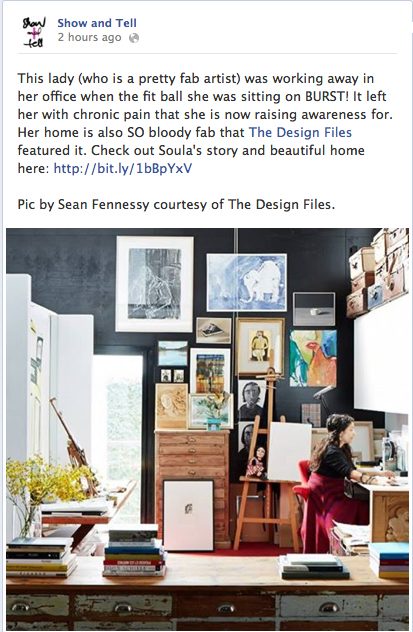Tell us about your history and how you ended up in the position of being an amazing woman advocating for chronic pain?
“I was working in our graphic design studio, Origin of Image (ooi.com.au) in March 2007. I was always health conscious so aside from my yoga ritual 4 mornings a week and walking everywhere, I would often sit on a fitball. It was great until the antiburst fitball burst and I fell to the concrete floor. It really was the split second that changed my life. I was 37.
I think what tipped me into advocacy was the 4.5 years it took to find a diagnosis and the near miss I had with living out the rest of my life in horrific pain levels if I’d not investigated further. My chronic pelvic pain is more specifically known as Pudendal Neuralgia (PN) or Pudendal Nerve Entrapment (PNE). This is more simply put as Carpal Tunnel in the pelvis. Where Carpal Tunnel affects the hand signals and hand movements, Pudendal Neuralgia affects our biggest pelvic nerve which controls toilet and sexual signals and functions. The pudendal nerve runs under pelvic ligaments and muscles and is attached to nerve roots in the lumbosacral spine so it can be disabling. It feels like that core part of my body has a toothache or as if I have my finger stuck in a powerpoint. BUT, I’m happy to say I’m in a much better place now and that’s why I want to share my story.
I believe if I was diagnosed within 6 months of my injury, I would not have this issue now and that makes me want to reach everyone with undiagnosed pain that may be suffering from PN.
I’ve also been drawn to advocacy for injured workers since I’ve now had first hand experience with the WorkCover system and its limitations for understanding, assessing and treating chronic pain. In fact my chronic pain issue was not assessable for compensation. Its score was rated at 0% impairment.
I’ve also submitted many complaints and questions to WorkSafe and associated organisations, I’m making a heap of noise on social media and gathering a great group of people in the hope of making a change. A network exists now, encouraging other injured workers to speak up, forming communities for support where there were none previously. Injured workers can now vent, speak up, be heard. Social media has provided a voice and is our legs (even when we physically can’t move).
So in the process of advocating for PN/PNE the biggest tasks are to change the judgment and misunderstanding of ‘pain’, and misconceptions of the term ‘injured worker’.”











